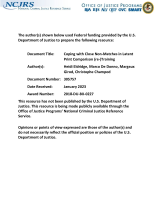Automated Fingerprint Identification System (AFIS)
On the utility of extended fingerprint features: A study on pores
Automated Fingerprint Identification Systems: Their Acquisition, Management, Performance and Organizational Impact Final Report
Advancing Justice for the Missing and Unidentified Through Research - 2024 NIJ Research Conference
Forensic science research is developing essential knowledge to fill in the holes in death investigations, creating new ways to identify challenging skeletal remains. These methods inform cause of death, time of death, and familial relationships to guide investigations, identify suspects, support prosecutions, and bring justice to families.
See the YouTube Terms of Service and Google Privacy Policy
LQM: Localized Quality Measure for Fingerprint Image Enhancement
Latent Fingerprint Interoperability - Survey Local Addendum
Latent Fingerprint Interoperability Survey - Core Questionnaire
The relation between sensitivity, similar non-matches and database size in fingerprint database searches
Quantitative evaluation of latent fingermarks with novel enhancement and illumination
Contextual biometric watermarking of fingerprint images
An Improved Method to Watermark Images Sensitive to Blocking Artifacts
Embedding Biometric Identifiers in 2D Barcodes for Improved Security
Coping with Close Non-Matches in Latent Print Comparison (re-)Training
Latent Fingerprint Interoperability - Survey State Addendum
Fingerprint Sourcebook (Appendices)
Fingerprint Sourcebook (Preface)
Fingerprint Sourcebook - Chapter 6: Automated Fingerprint Identification System (AFIS)
Fingerprint Sourcebook - Chapter 4: Recording Living and Postmortem Friction Ridge Skin Exemplars
How Police Policies and Practices Impact Successful Crime Investigation: Factors That Enable Police Departments to "Clear" Crimes
Expanding Research to Examine the Impacts of Forensic Science on the Criminal Justice System
In 2004, the National Institute of Justice created the social science research on forensic sciences (SSRFS) research program to explore the impact of forensic sciences on the criminal justice system and the administration of justice. Much of the early research from the SSRFS program focused on DNA processing and the use of DNA in investigations and prosecutions.
See the YouTube Terms of Service and Google Privacy Policy



